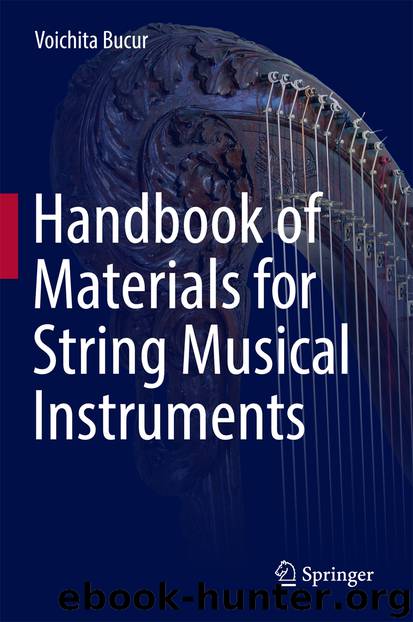Handbook of Materials for String Musical Instruments by Voichita Bucur

Author:Voichita Bucur
Language: eng
Format: epub
Publisher: Springer International Publishing, Cham
Fig. 10.19Elastic storage mechanism in collagen (type I). The model for a collagen molecule proposed by Silver et al. (2002), is composed from rigid regions (12-rectangles) and flexible regions (springs). Legend Positive staining bands of the collagen period c 2 , c 1 , b 2 , b 1 , a 4 , a 3 , a 2 , a 1 , e 2 , e1 d and c 3 ). L + ΔL-elongation under applied force in e 2 , e 1 and d (Silver et al. 2002, Fig. 2, p. 1984)
The model hypothesized that the external forces may be in equilibrium with forces exerted by cells on the extracellular matrix. The behaviour of the structure in tension is dependent on the structural architecture of its elements. Springs correspond to flexible regions of different constituents. The flexible regions are associated with 12 positive staining bands in collagen fibril. Springs are pairs charged which resist elongation. The energy storage occurs in the flexible regions. The rigid sections transfer stress through the molecule. The energy is absorbed by breaking electrostatic interactions (±) between amino acid side chains.
The collagen molecules have rigid and flexible regions, which react differently to stress. Mechanical properties are related to the elastic stretching of the non-helical ends, the cross-links and the triple helix. The mechanism of elastic storage is related to the separation of these constitutive elements. Because of the structural characteristics, the mechanical behaviour is different at low strain and at high strain. At low strain, collagen fibrils and fibres are uncramped. At higher strain molecular stretching and slipping of fibrils and fibres occurs. The viscous behaviour, inducing sliding of the collagen fibrils, can determine the alignment of these elements in the force direction and can dissipate the action of the applied force. If the external force increases, at break point the cross-links between fibrils break and fracture occurs. Table 10.6 gives some mechanical data of collagen and elastin compared with synthetic materials such as carbon fibres and Kevlar . In the future the remarkably high extensibility of these two elastic proteins could inspire new materials via biotechnology.Table 10.6Mechanical properties of elastic protein (elastin and collagen) compared with synthetic materials (data from Gosline et al. 2002)
Download
This site does not store any files on its server. We only index and link to content provided by other sites. Please contact the content providers to delete copyright contents if any and email us, we'll remove relevant links or contents immediately.
Aircraft Design of WWII: A Sketchbook by Lockheed Aircraft Corporation(32140)
The Great Music City by Andrea Baker(30809)
Call Me by Your Name by André Aciman(19943)
The Art of Boudoir Photography: How to Create Stunning Photographs of Women by Christa Meola(18415)
The Secret History by Donna Tartt(18237)
Shoot Sexy by Ryan Armbrust(17565)
Plagued by Fire by Paul Hendrickson(17119)
Portrait Mastery in Black & White: Learn the Signature Style of a Legendary Photographer by Tim Kelly(16878)
Adobe Camera Raw For Digital Photographers Only by Rob Sheppard(16806)
Photographically Speaking: A Deeper Look at Creating Stronger Images (Eva Spring's Library) by David duChemin(16508)
Ready Player One by Cline Ernest(14036)
Pimp by Iceberg Slim(13809)
Bombshells: Glamour Girls of a Lifetime by Sullivan Steve(13706)
The Goal (Off-Campus #4) by Elle Kennedy(13213)
Art Nude Photography Explained: How to Photograph and Understand Great Art Nude Images by Simon Walden(12859)
Kathy Andrews Collection by Kathy Andrews(11346)
The Priory of the Orange Tree by Samantha Shannon(8646)
Thirteen Reasons Why by Jay Asher(8477)
The remains of the day by Kazuo Ishiguro(8419)
